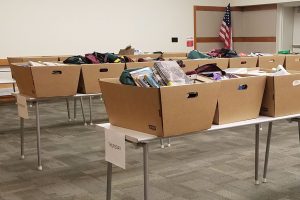
From quickly setting up curbside service to figuring out virtual programming, libraries around the country have had to scramble to react to the ever-changing realities of the coronavirus pandemic, all while trying to keep staffers and patrons safe. Some libraries that have reopened after closing in the early stages of the global crisis have been forced to close again—temporarily or for a longer term—for reasons ranging from staff members testing positive to patrons flouting safety measures.
Since it first reopened some locations for curbside service on May 18, Shreve Memorial Library (SML) in Shreveport, Louisiana, has had to close branches on 20 occasions because staffers were exhibiting symptoms or had tested positive for COVID-19. The first closure occurred on May 26 when SML was only offering curbside, but SML continued to start opening to the public with limitations in seven branches on June 10. Some of the system’s 21 branches have closed more than once.
“At times, it’s stressful, but we make it known that we’re all new at this and we’re all adjusting to what the governor mandates and the CDC recommends,” says Deonci Sutton, associate director for public services at SML. “We’re managing.”
As of July 31, Louisiana had the highest rate of coronavirus cases per 100,000 people of any US state. Decisions about library operations come from the director and 10-member board of control, which includes the city’s mayor and the Caddo Parish Commission president.
“We do our own contact tracing, as far as employees go,” Sutton says. Branches are open for curbside pickup and limited service that allows 30-minute visits with a 25% capacity for each location. If an onsite employee shows symptoms or is exposed to the virus, the branch is closed for 24 hours as a precaution. Still, Sutton says, “In addition to it being stressful, I will also say it’s scary.”
Government guidelines, mask meltdowns
Summersville (W.Va.) Public Library (SPL) had to close three days after reopening because a patron defied the state’s mask mandate and intentionally coughed on books and computers. When SPL opened its doors, it limited the number of visitors in the building by requiring people to make appointments, but some of those who made appointments brought additional guests. On July 9, one of those guests challenged the mask policy, allegedly becoming verbally aggressive, removing her mask, and potentially contaminating materials before agreeing to leave.
“Our staff was upset, I was upset,” says SPL Director Cynthia Hagen. “Gauging our community and how we saw discussions online about masks, we felt this would not be the only issue.”
The library closed to regroup, returning to offering curbside-only service with hopes to reopen on a limited basis again.
Some Columbus (Ohio) Metropolitan Library (CML) branches had been reopened for a few weeks but had to close when Gov. Mike DeWine issued restrictions for the state.
“The staff took that very hard because it was nice to see the customers again and offer some services,” says Andrea Villanueva, manager of the Northern Lights branch. “It felt [previously] like we were heading toward a new normal.”
Library staffers had been adjusting to helping customers in contactless ways, using laser pointers and rolling plexiglass shields librarians can maneuver to help bridge the gap while physically distant. During the full closure, CML has had to innovate. In addition to curbside service, five locations have drive-through windows, which allow patrons to pick up “grab-and-go” materials selected by staff based on age or interest, or even printouts and faxes using mobile technology. CML also offers virtual services that were previously accessible in person, such as homework or genealogy research help. Programs like free lunches for kids during the summer are now offered in some branch parking lots.
“Everything is day-to-day,” Villanueva says. “The new norm is just change, change, change. We’ve had to be very innovative to make sure we’re meeting the community needs.”
CML’s decision to remain closed was influenced by the governor’s assessment of where the county stands in relation to the state’s tiered advisory system, says CML CEO Patrick Losinski. If the county remains stable, the library could start to reopen again.
“It’s like a series of stops and starts,” says Losinski. “It’s exasperating at times. Our employees are looking for some certainty, continuity, and consistency. News can come out, and within an hour we’re changing plans.”
After city government issued a mandate for total closure on March 14, Jacksonville (Fla.) Public Library (JPL) reopened on June 4. Since then two branches had to temporarily close when staff members contracted COVID-19.
“Fourth of July weekend, I got a call that an employee had tested positive,” says Julie McNeil, deputy director of public services at JPL. “The library branch was closed for a day [for cleaning]. We sent almost the whole staff off to get tested. The good news was that none of the employees who were tested came back positive.
A week later, another positive staff test prompted a 24-hour closure at another branch. JPL continues to offer curbside service at 16 of its 21 locations, and five of the larger locations remain open to patrons at 50% capacity. Anyone who wishes to enter must get a temperature check, wear a mask, and practice physical distancing etiquette while indoors.
“Our staff has really had to adapt,” McNeil says. She says that anxiety among the more than 400 employees of JPL has preceded everything from setting up curbside service to reopening a temporarily closed building, but they continue to acclimate to the challenges. “I feel like all I do is say: ‘Thank you for being flexible.’”


